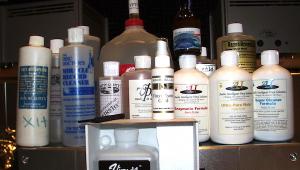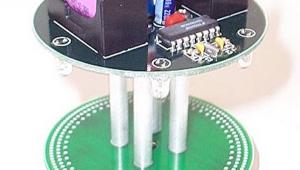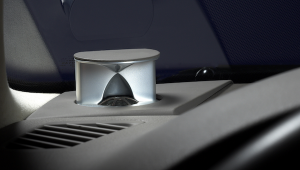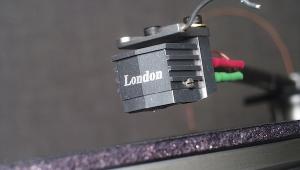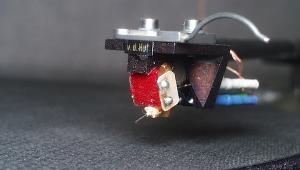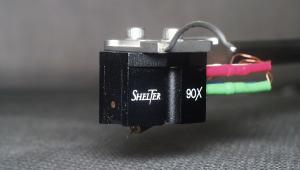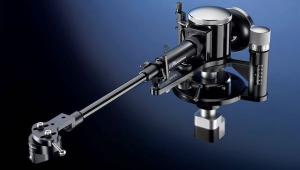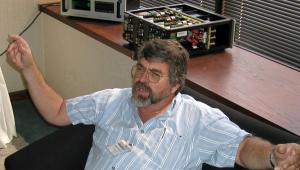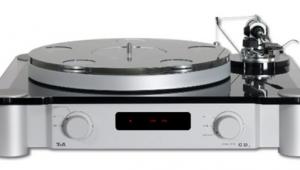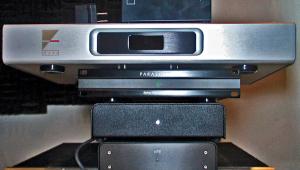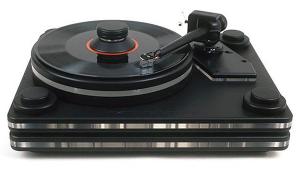I understand that the slit/aperture moves with the stylus causing the static light source to shine onto a photo-detector. Of primary concern would be the array size of the photo-detector. Such an array would in effect result in a quantized measurement of the instantaneous position of the light through the slot. Knowing the current position and the prior position would allow the calculation of the velocity-vector of the slot movement which would be analogous to the relative movement of a magnet and coil. The primary difference being the former is limited to the resolution of the photo-detector array and the latter the inherent physical noise of the system. If I'm correct in the assumption of the use of a photo-detector array which outputs the presence or lack of light and not the intensity on an individual pixel, then the optical cartridge has some commonality with a digital system.
Analog Corner #241
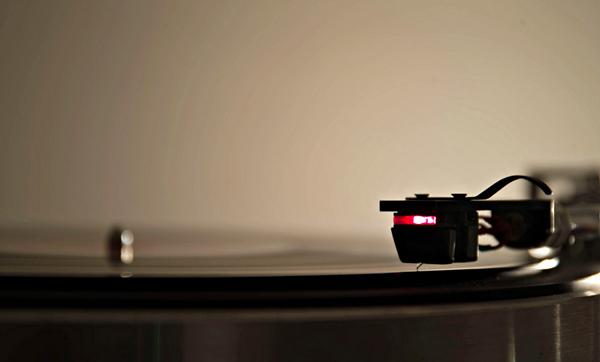
More good news: The DS-W1 optical cartridge plus its associated electronics, which replace the phono preamp, cost only $8500—less than the price of many high-end cartridges alone (footnote 1). (Of course, many great cartridges and phono preamps cost much less.)
Toshiba introduced the first optical cartridge, the C-100P, in the 1970s. It had a filament-based lamp that produced a lot of heat and was prone to failure. The DS-W1's LED produces almost no heat, and has a (presumably) much longer lifespan.
It turns out that Hamaguchi Kazuo, the designer of the Toshiba C-100P, is still around. A few years ago he was happy to help the DS-W1's young designer, Tetsuaki Aoyagi—now 28—adapt the original optical-cartridge design to more modern technology. Lyra's Jonathan Carr also lent assistance. So did Aoyagi's father, Tesuji "Ted" Aoyagi, who was involved in the development of the optical mouse and joystick, and worked for Nakamichi when that company made turntables. (One of those turntables used an optical sensor to determine groove eccentricities and correct for them by shifting the platter top. We need that again!)
The DS-W1 looks like a typical moving-magnet or moving-coil cartridge—until you turn on its outboard equalizer-power supply, which makes the cartridge's "headlight" glow red (footnote 2). In this regard, the DS-W1 is similar to The Soundsmith's Strain Gauge cartridge, which also requires a dedicated equalizer and power source. The Soundsmith's outboard electronics are offered in different sizes and levels of refinement—and at different prices—but the equalizer-power supply for the DS-W1 comes in one flavor only: a 12.7" by 8.2" by 3.7" (W x D x H) box with a power switch on its front panel and RCA input and output jacks on its rear panel.
Most of the specifications for the DS-W1 will sound familiar to cartridge shoppers: a recommended vertical tracking force (VTF) of 1.3–1.7gm, with an optimal setting of 1.5gm; a body of machined aluminum; a weight of 6.5gm; and channel separation rated—conservatively, I think—at 20dB "or more," which is a good 5dB lower than the specs for most MMs and MCs. The output is specified only in terms of equalizer output, which is 500mV or more, and designed to feed a line-level input.
An MC cartridge's relatively low moving mass offers advantages over an MM's heavier mass, and one of the optical cartridge's biggest advantages is the very low mass of its moving parts—even lower than that of an MC. The DS-W1 has neither coils nor magnets. Instead, attached to its cantilever is a tiny, 50µm-thick "slit plate," whose movement modulates a beam of light as it travels from an LED mounted in front of the miniscule plate to a photodetector behind it. Because that movement is synced to the physical information in the groove, the voltage output of the photodetector is an analog of the music signal.
Velocity-proportional vs amplitude-proportional playback
Standard MM and MC cartridges are velocity-proportional: As electromagnetic devices, they produce output voltages that are proportional to the velocity of the stylus—the distance it travels per a given unit of time—and not the degree of its displacement in the groove. Such cartridges will exhibit flat response only when playing a groove modulation that was made a constant velocity from the cutter head. (Creating constant-velocity modulations comes naturally by applying a 6dB/octave increase to the audio signal prior to master disc cutting, which is the RIAA emphasis, but read on.)
Optical and strain-gauge cartridges, on the other hand, are amplitude-proportional devices: Their outputs are (directly) proportional to amplitude—ie, to the stylus's degree of physical displacement. The frequency response of an optical cartridge will be flat only when its stylus traces a constant-amplitude groove modulation.
In theory, record grooves can be cut with constant-velocity or constant-amplitude modulations—the latter accomplished with electronic compensation—though neither method is consistently practical in reality, due to the wide range of signal frequencies involved and other technical concerns. An exclusively constant-velocity cut, for instance, would result in enormous, space-wasting excursions at low frequencies and, at higher frequencies, excursions too small to be trackable and/or to rise above the noise floor.
The solution? Every record in your collection was cut using constant velocity and constant amplitude. Frequencies between 500.5 and 2121.5Hz, and a narrow "shelf" of the lowest frequencies below 50.5Hz, were cut with constant velocity. Yet, in keeping with the RIAA pre-emphasis curve, most of the bass range and all of the treble range were cut with constant amplitude, so that the low frequencies were attenuated and the high frequencies were amplified. That bass cut and treble boost are reversed by the RIAA de-emphasis stage in your home gear, to produce, ideally, flat response during playback (footnote 3).
The reverse-equalization stage in your phono preamp is designed around the presumed standard in playback equipment: a velocity-proportional MM or MC cartridge. Yet DS Audio's amplitude-proportional optical cartridge requires a much different and far less steep playback curve—which is why the DS-W1, like the Soundsmith Strain Gauge cartridges, comes with its own electronics. To produce flat output response, the DS-W1's equalizer must compensate in the two regions of the RIAA pre-emphasis curve where groove-cutting is constant velocity: between 500.5 and 2121.5Hz and below 50.5Hz. Above 2121.5Hz, the DS-W1 is not sensitive to the treble boost that a constant-amplitude groove—itself a product of RIAA pre-emphasis—would elicit from a velocity-proportional cartridge. It's fair to say that amplitude-proportional cartridges perfectly decode, without electronic assistance, frequencies from 20kHz down to 2121.5Hz.
In fact, while the RIAA playback curve requires about a hundredfold difference in level (40dB) between the highest and lowest frequencies, the amplitude-proportional DS-W1 requires only a threefold difference in level (10dB). In other words, for the most part, amplitude-proportional playback inherently produces close to a flat response with little compensation needed.
That's just one of an optical transducer's advantages. In addition is something called Lenz's Law: In 1835, Russian physicist Heinrich Lenz stated, "An electric current induced by a changing magnetic field will flow such that it will create its own magnetic field that opposes the magnetic field that created it." In other words, in a standard MM or MC cartridge, the signal produced by the vibrating stylus and cantilever will be opposed by an electromagnetic force of its own making—a force that will, to some degree, inhibit the stylus's ability to faithfully track the groove. The DS-W1 does not suffer from this.
In short, amplitude-proportional cartridges seem to have three major advantages over velocity-proportional types: lower mass, no Lenz law electromechanical blowback, and less severe equalization. But I figured there must be some drawback to optical cartridges.
In preparing for this review, I contacted some people who know more than I do about vinyl cutting and playback. All agreed that from 2121.5Hz to 20kHz, amplitude-proportional cartridges display exemplary behavior in the frequency and phase domains, and without needing any electronic processing during playback. However, there is a potential low-frequency problem in the sub-50.05Hz constant-velocity shelf.
As I've pointed out, from 50.05 to 500.5Hz, record-cutting is constant-amplitude, to save groove real estate—which makes sense, but requires compensation in playback because MM and MC cartridges will not exhibit a linear response when reading such groove modulations. However, the RIAA system's designers chose to revert to constant-velocity cutting below 50.05Hz by leveling-off the equalization and simply letting the cutter head do its thing and cut flat, with no filter imposed.
Why? Because, without that equalization, a velocity-proportional MM or MC cartridge produces a flat response from 50.05Hz down to the lowest frequencies. Had the RIAA opted for constant amplitude all the way down, that low bass would have required a 6dB/octave de-emphasis boost to maintain a flat playback response—which would also boost rumble and noise from the turntable's platter and motor.
When the DS-W1 reproduces frequencies below 50.05Hz, it naturally boosts response 6dB/octave in that region. That means its equalizer should effect a 6dB/octave cut to achieve a flat low-frequency playback response. However, my contacts told me that it's trickier to correctly implement such a thing.
Theory vs Sound
What we learn from the above is that no system of vinyl playback works well, so we'd be better off switching to CDs. You can learn much the same online, where CD-resolution digital is described as simple and perfect: Nyquist is all you need to know, brickwall filters are perfect, there's no such thing as jitter, and 16-bit resolution is more than sufficient—and never mind what happens at low levels.
But in the real world, for some crazy reason or reasons, my ears—and probably yours—prefer vinyl playback, finding that it sounds more musical. More like reality.
I mounted the DS-W1 cartridge in my Kuzma 4Point tonearm and plugged its output into DS Audio's dedicated equalizer. I compared it to the sound of an Ortofon A95 MC cartridge mounted in Continuum Audio Labs' Cobra tonearm, its output fed into Ypsilon Audio's MC-16L step-up transformer and VPS 100 phono preamp. Not including the prices of the tonearms, I was comparing the $8500 DS-W1 rig to about $41,500 worth of cartridges and preamps.
Especially if you've invested the latter sum in your analog front end, you'd expect and hope that the far more expensive combo would outperform the lower-priced one. But given the DS-W1's touted technological advantages, all bets would be off until the styli hit the grooves.
If I expected a big "wow" on first hearing the DS-W1, I was disappointed—and that was a good thing: It's not likely that I've been enjoying my records incorrectly all these years. In fact, I didn't immediately notice anything much better about the DS-W1's sound except in one area: the bass. With every familiar record I played, I heard more bass than I expected or was used to hearing. The emphasis allowed the bass line to almost dominate the music. At first, the added rhythmic emphasis got my toes tapping and drove the music forward.
But a half-dozen records later, all that bass boost began to obtrude. It was like climbing into a rental car and finding that the previous driver had selected the "smiley-face" equalizer setting: boosted bass and treble—and, between them, a suppressed midrange. Not that the DS-W1 boosted the treble or suppressed the midrange, but it sure boosted the bass—and I don't have a tone control to drop it the necessary few dB.
Could it be the DS-W1 was getting the bass correct, and the Ortofon A95 was attenuating it? That's where digital came in handy: I compared some CDs with their vinyl counterparts—same mastering engineers and same source tapes, as in some Mobile Fidelity SACD/CDs—and found that the A95's bass more closely tracked that of the digital version. The optical cartridge's increased bass also was somewhat less well defined and coherent, with softer transients, though the bass's harmonic structure and tunefulness were very good. So I'm confident that DS Audio hasn't quite got the DS-W1's de-emphasis right, or has chosen to boost the bass for its excitement value—the latter of which, if true, strikes me as an unfortunate choice.
That said, the DS-W1's excess bass rarely turned into midbass bloat. That makes me think that the problem had more to do with how DS Audio's electronics, in their present state, handle the equalization than with an inherent flaw in the cartridge itself.
If your system is bass-shy, the DS-W1 may be the quicker picker-upper you're looking for, but I don't think it's the correct way to balance a system's sound. Consider: The DS Audio preamp-power supply includes a subsonic filter, selectable by means of an auxiliary pair of output jacks, for "bent" (warped) records—but this didn't fix the bass excess.
Above that region of boosted bass, things were much better. The benefits of low mass and what I presume to be the absence of Lenz-effect blowback produced nothing less than revelatory transparency and spatial clarity, though those qualities were not immediately apparent to me, and the boron cantilever and Shibata stylus supplied an abundance of detail.
I've been going through the new boxed set of Roxy Music's The Complete Studio Albums (8 LPs, Virgin EGBSX 1), mastered from 24-bit/96kHz files. Of course, we'd all prefer that they'd been cut from the analog master tapes, but engineer Miles Showell at Abbey Road has done a thorough half-speed mastering that well matches the equalization of most of the original UK LPs, which were in no need of "modernization" or improvement. Unfortunately, the A/D and D/A converters used have made an audible signature on all of these reissues—something the original pressings don't have.
Yes, the electronics of analog tape decks, mixing boards, and cutter heads all affect a record's final sound, but digitization and reconstitution are fundamental, game-changing meat grinders compared to the effects of analog electronics. In any case, the DS-W1's retrieval and resolution of low-level details, and its inherent transparency, let me hear well into the farthest corners of such congested tracks as "The Thrill of It All," from Country Life. In that respect, the Ortofon-Continuum combo was not quite as good as the DSA-Kuzma. But overall I much preferred the Ortofon's rendering through the Ypsilon electronics, which was free of that distracting bass boost, and of the converter signature that, over time, became all too clear through the DS-W1.
Two more observations
Sanctuary Records has just issued, from the Pye master tapes cut by Kevin Gray at Cohearent Mastering, the first four albums by the Kinks, including Ray Davies's early masterpiece Face to Face (LP, Pye/Sanctuary BMG 14051 V). It's a simple—some would say primitive—Shel Talmy mono production (was Talmy capable of any other kind?) that has never sounded this good—and I've got mint Pye originals. The tom-toms in "Holiday in Waikiki," and every element in the dreamy, hypnotic "Fancy," sounded far more three-dimensional and resolved through the Ortofon A95. By comparison, the DS-W1 sounded somewhat glazed and less resolving of low-level information.
I also compared the DS-W1's and A95's renderings of "Cut Me Some Slack," Paul McCartney, Krist Novoselic, and Pat Smear's contribution to Sound City: Real to Real, Dave Grohl's vinyl ode to a Neve console (2 LPs, RCA 44992-1). Even though I was put off by the excess bottom end and slight electronic glaze of the DSA electronics, I became an instant believer in the optical cartridge's potential: The transparency, and the removal of a layer of haze, were startling and remarkable—as if someone had cleaned a camera's Lenz.
Takeaway
I spent a great deal of time with DS Audio's DS-W1 cartridge and electronics. The cartridge itself is a major breakthrough, held back from true audio greatness by distractingly over-emphasized bass that is probably the result of flawed correction of the RIAA pre-emphasis, and mid-fi electronics that produced a slight glaze and somewhat flattened image dimensionality.
Had it not been for that off-putting bass emphasis, I'd have tried to compare the $8500 DS-W1 with a similarly priced combination of cartridge and phono preamp, which would have been a fairer comparison than with the $41,500 Ortofon-Ypsilon combo.
On the other hand, given the cost of a top-shelf cartridge and phono preamp today, the $8500 DS-W1 package is certainly worth an audition—especially if DS Audio can upgrade their electronics and fix the bass problem (and offer the fix as a swap-out for units in the field). In a bass-shy system, the DS-W1 as is might be a very hot ticket to analog ecstasy, but boosted bass from a phono equalizer is not my preferred method of audio transport.
Postscript: Michael Fremer reviews DS Audio's Master1 optical phono cartridge in the October 2018 issue of Stereophile.—Ed.
Footnote 1: DS Audio, 4-50-40, Kamitsuruma-Honcho, Minami-ku, Sagamihara, Kanagawa 252-0318, Japan. Tel: (81) 427-47-0900. Fax: (81) 427-47-6011. Web: www.ds-audio-w.biz. US distributor: Musical Surroundings, 5662 Shattuck Avenue, Oakland, CA 94609. Tel: (510) 547-5006. Fax: (510) 547-5009. Web: www.musicalsurroundings.com.
Footnote 2: Garth Leerer of Musical Surroundings says this light inspired him and his co-workers to nickname the DS-W1 "the Night Rider," in reference to the pimped-up Pontiac TransAm from the mid-'80s television series Knight Rider. The principals of DS Audio were delighted when they heard that, and have begun using the name themselves. Life imitates art.—Art Dudley
Footnote 3: For greater detail, including charts and graphs, see "Analog Corner" in the May 2014 issue of Stereophile, Vol.37 No.5.
- Log in or register to post comments


The optical cartridge goes back much further. Look up the Philco "Beam of Light" system from the 40s.

"what I presume to be the absence of Lenz-effect blowback produced nothing less than revelatory transparency and spatial clarity" -- interesting how critical it is at the phono cartridge stage, but not anywhere else it occurs in the recording & playback chain.
Anyway, I decided to bypass Lenz's law in my MM cartridge. And after upgrading the coils to a low gauge wire, I now power my home from it. I like it better than my cold fusion system.

Michael, how does it compare to the SoundSmith Strain Gauge?
